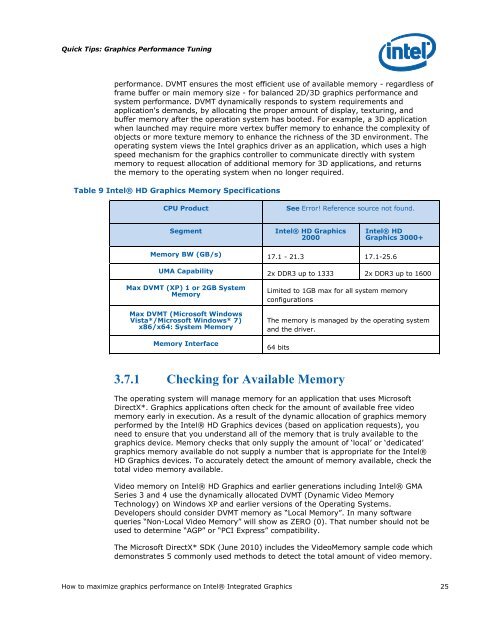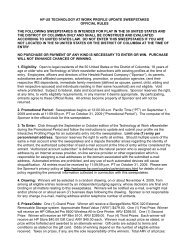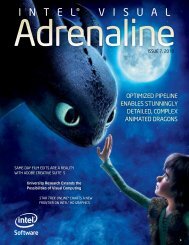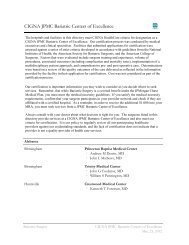Intel HD Graphics DirectX Developer's Guide (Sandy Bridge)
Intel HD Graphics DirectX Developer's Guide (Sandy Bridge)
Intel HD Graphics DirectX Developer's Guide (Sandy Bridge)
Create successful ePaper yourself
Turn your PDF publications into a flip-book with our unique Google optimized e-Paper software.
Quick Tips: <strong>Graphics</strong> Performance Tuning<br />
performance. DVMT ensures the most efficient use of available memory - regardless of<br />
frame buffer or main memory size - for balanced 2D/3D graphics performance and<br />
system performance. DVMT dynamically responds to system requirements and<br />
application's demands, by allocating the proper amount of display, texturing, and<br />
buffer memory after the operation system has booted. For example, a 3D application<br />
when launched may require more vertex buffer memory to enhance the complexity of<br />
objects or more texture memory to enhance the richness of the 3D environment. The<br />
operating system views the <strong>Intel</strong> graphics driver as an application, which uses a high<br />
speed mechanism for the graphics controller to communicate directly with system<br />
memory to request allocation of additional memory for 3D applications, and returns<br />
the memory to the operating system when no longer required.<br />
Table 9 <strong>Intel</strong>® <strong>HD</strong> <strong>Graphics</strong> Memory Specifications<br />
CPU Product See Error! Reference source not found.<br />
Segment <strong>Intel</strong>® <strong>HD</strong> <strong>Graphics</strong><br />
2000<br />
<strong>Intel</strong>® <strong>HD</strong><br />
<strong>Graphics</strong> 3000+<br />
Memory BW (GB/s) 17.1 - 21.3 17.1-25.6<br />
UMA Capability 2x DDR3 up to 1333 2x DDR3 up to 1600<br />
Max DVMT (XP) 1 or 2GB System<br />
Memory<br />
Max DVMT (Microsoft Windows<br />
Vista*/Microsoft Windows* 7)<br />
x86/x64: System Memory<br />
Memory Interface<br />
Limited to 1GB max for all system memory<br />
configurations<br />
The memory is managed by the operating system<br />
and the driver.<br />
64 bits<br />
3.7.1 Checking for Available Memory<br />
The operating system will manage memory for an application that uses Microsoft<br />
<strong>DirectX</strong>*. <strong>Graphics</strong> applications often check for the amount of available free video<br />
memory early in execution. As a result of the dynamic allocation of graphics memory<br />
performed by the <strong>Intel</strong>® <strong>HD</strong> <strong>Graphics</strong> devices (based on application requests), you<br />
need to ensure that you understand all of the memory that is truly available to the<br />
graphics device. Memory checks that only supply the amount of „local‟ or „dedicated‟<br />
graphics memory available do not supply a number that is appropriate for the <strong>Intel</strong>®<br />
<strong>HD</strong> <strong>Graphics</strong> devices. To accurately detect the amount of memory available, check the<br />
total video memory available.<br />
Video memory on <strong>Intel</strong>® <strong>HD</strong> <strong>Graphics</strong> and earlier generations including <strong>Intel</strong>® GMA<br />
Series 3 and 4 use the dynamically allocated DVMT (Dynamic Video Memory<br />
Technology) on Windows XP and earlier versions of the Operating Systems.<br />
Developers should consider DVMT memory as “Local Memory”. In many software<br />
queries “Non-Local Video Memory” will show as ZERO (0). That number should not be<br />
used to determine “AGP” or “PCI Express” compatibility.<br />
The Microsoft <strong>DirectX</strong>* SDK (June 2010) includes the VideoMemory sample code which<br />
demonstrates 5 commonly used methods to detect the total amount of video memory.<br />
How to maximize graphics performance on <strong>Intel</strong>® Integrated <strong>Graphics</strong> 25













